New Mexico
Science and Scenery
October 2010
Introduction:
New Mexico has special appeal for us with its rich history of
scientific research and development. Marsha and I put
together an 8 day trip with my sister, brother-in-law and their
son, all of which have interest in the sciences, SW culture
and scenery.
During part of my career, I led the development of
state-of-the-art high speed signal digitizers at Tektronix for the
nuclear industry and worked with these labs for a number of
years. One I remember well was the Kirkland AFB "Trestle"
project.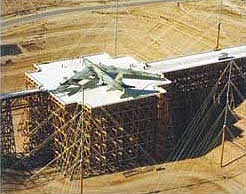 It was important at the
time to study the effects of HEMP
(High Altitude Electromagnetic Pulse) from nuclear
detonations high in the atmosphere. The early days of
testing revealed that something was taking out electronics 100's
of miles distant from the tests. One famous example was the
partial shutdown of the honolulu telephone system during an
atmospheric nuclear test in the mid pacific. Street lights
and other electronics were also effected. This was 800 miles
away! Researchers realized that so called compton electrons
were formed by the gamma
radiation and they needed to find ways of shielding from the very
strong HEMP that was generated. Atmospheric testing had come
to an end by treaty so the scientists decided to build a platform
that could allow full size airplanes to be placed upon it but it
couldn't contain much metal--no metallic nuts and bolts....
nothing metallic. Hence it became the worlds largest
structure made of wood. B-52 shown in the picture is ready
for testing. Kirkland AFB generated a 44 minute movie that
describes its history and construction. You can view it here.
They claimed that they held up testing waiting for our digitizers.
It was important at the
time to study the effects of HEMP
(High Altitude Electromagnetic Pulse) from nuclear
detonations high in the atmosphere. The early days of
testing revealed that something was taking out electronics 100's
of miles distant from the tests. One famous example was the
partial shutdown of the honolulu telephone system during an
atmospheric nuclear test in the mid pacific. Street lights
and other electronics were also effected. This was 800 miles
away! Researchers realized that so called compton electrons
were formed by the gamma
radiation and they needed to find ways of shielding from the very
strong HEMP that was generated. Atmospheric testing had come
to an end by treaty so the scientists decided to build a platform
that could allow full size airplanes to be placed upon it but it
couldn't contain much metal--no metallic nuts and bolts....
nothing metallic. Hence it became the worlds largest
structure made of wood. B-52 shown in the picture is ready
for testing. Kirkland AFB generated a 44 minute movie that
describes its history and construction. You can view it here.
They claimed that they held up testing waiting for our digitizers.
Today, the structure has been inactive since 1995 with no funds
available to maintain. The designer, Dr. Carl E. Baum is no
longer alive having met him in the 1970's.
New Mexico has a wealth of scientific organizations centered
around early development of nuclear weapons, rocketry then later
for deep space research using the VLA (Very large Array).
I've always wanted to come back and see these and other special
places but never had the time. I wanted to see these sites
and new ones one last time and look up a few people I knew so many
years ago.
- Sandia National Labs
- National Museum of Nuclear Science
- Los Alamos National Labs
- Bradbury Museum
- Kirkland AFB
- EMRTC High Explosives Testing Laboratory
- Trinity site
- VLA (Very large Array)
- White Sands Missile test range, monument and museum
- Carlsbad Caverns
- Roswell, NM
- Santa Fe
Didn't get to all of them but had fun at what we did. All
the people I knew are retired now; the nostalgia was great!
National Museum of Nuclear Science and Trinity:
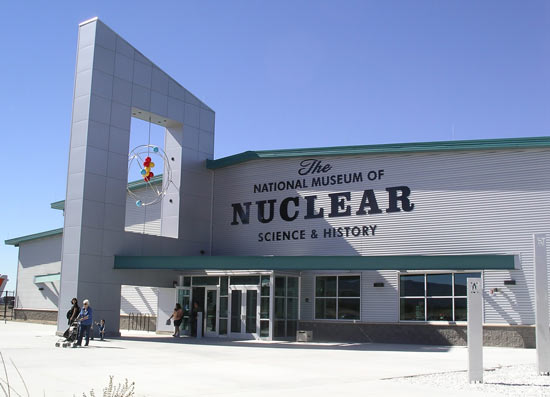 Over the years Kirkland
AFB had a museum devoted to nuclear weapons and early
testing. I use to enjoy visiting it whenever in town but
9-11 changed all that because public access was closed for
security reasons. Kirkland is a key base in the weapons
program where training takes place. The facility was split
into two parts, the "on base" secure facility and the Nuclear Museum
which now resides off base in SE Albuquerque. I do miss some
of the exhibits that the earlier museum had such as the "lady
Godiva" and raw uranium weight and radiation samples but I guess
that's the price you must pay for security.
Over the years Kirkland
AFB had a museum devoted to nuclear weapons and early
testing. I use to enjoy visiting it whenever in town but
9-11 changed all that because public access was closed for
security reasons. Kirkland is a key base in the weapons
program where training takes place. The facility was split
into two parts, the "on base" secure facility and the Nuclear Museum
which now resides off base in SE Albuquerque. I do miss some
of the exhibits that the earlier museum had such as the "lady
Godiva" and raw uranium weight and radiation samples but I guess
that's the price you must pay for security.
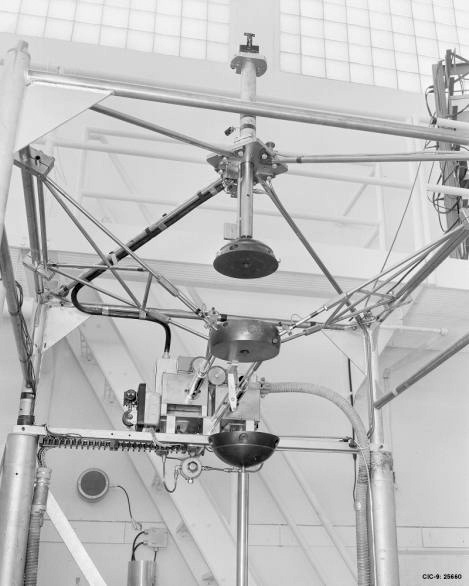
|
"Lady Godiva" facility showing segmented core,
no longer at new museum
|
Trinity Test Site
On July 16, 1945 the first prototype of the implosion Atomic Bomb
(called the 'Gadget') was detonated at Jornada del Muerto (Journey
of Death) desert in South Central New Mexico. This was the
initial culmination of the Manhattan Project. The Technical
Director, Robert Oppenheimer named the test, "Trinity". Many
books have been written about the project with some pictures and
details found here.
The "Trinity" test site is open to the public only two days a
year. One great way to visit is to arrange a bus trip
through the Nuclear Museum that includes docents that are retired
physicists and engineers from Sandia Labs and related
organizations. Our trip was scheduled so that we could visit
the "Trinity" site while in town. Being able to spend time
with some of the retirees was a real plus as we discussed some
experiments that took place, such as "Trestle". They told me I was
showing my age!
Being a typical engineer and interested in radiation monitoring,
I took my GM (Geiger-Müller) counter along. I knew ahead of
time that the site was cleaned up and radiation levels would be
low.
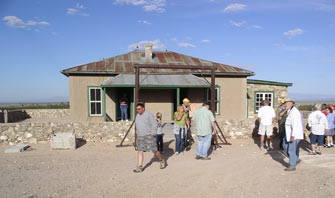 |
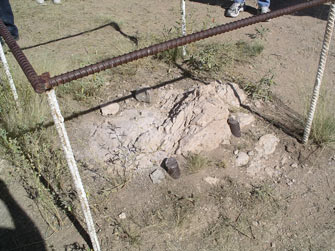 |
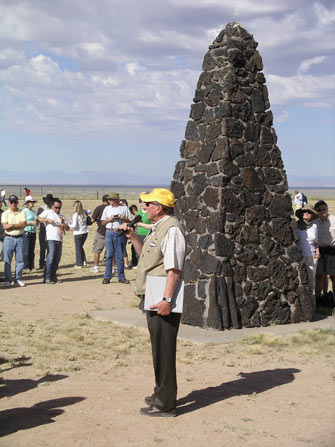 |
| McDonald Ranch House, where final assembly of
Plutonium pieces and neutron initiator were completed |
Only remains left of the tower that held the "gadget"
It vaporized in the explosion
|
Docent describing Ground Zero |
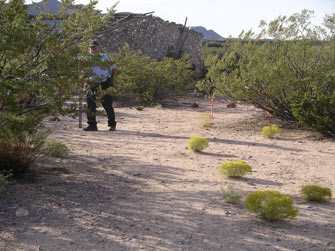
|
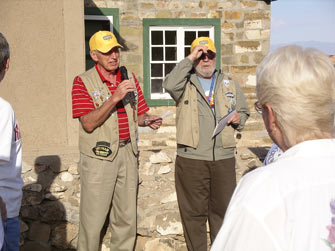
|
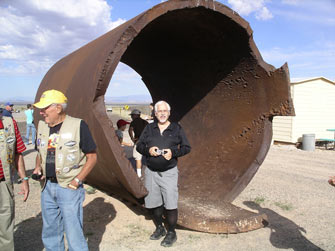
|
Ever present security hiding behind the bushes
|
Docents (yellow hats) giving lecture on the Trinity story
at McDonald. They're retired Sandia Physicists and
engineers
|
All that remains of "Jumbo". An approach to an
intermediate test that was ruled out as the development
advanced
|
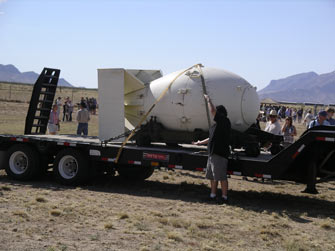 |
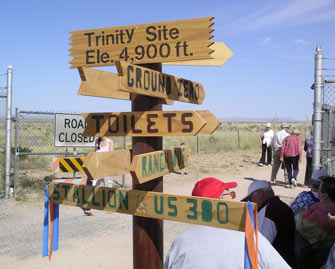 |
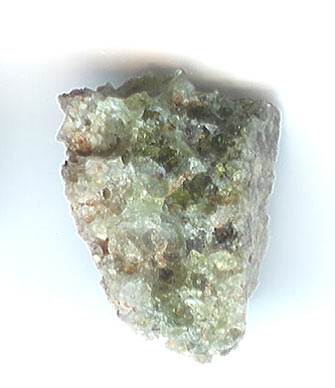
|
| Fatman, weaponized version of the "gadget" |
Central point outside ground zero
|
Trinitite: fused sand found under "gadget" detonation
-Still radioactive today-
|
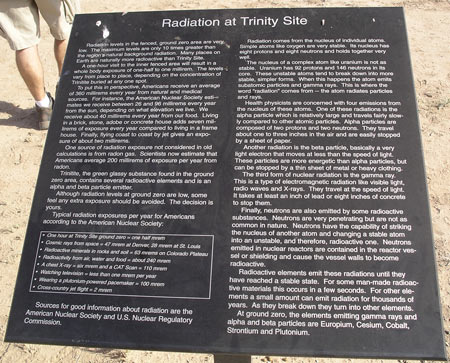 |
Any visit to a radioactive site
always raises the question as to how much exposure am I
going to receive? Being a retired engineer, I couldn't
resist the opportunity to do some measurements of my
own. I carried a RADALERT GM counter which is
sensitive to alpha,
beta and gamma
radiation to various degrees.
The background radiation well
outside the test site was averaging about 15 CPM (counts
per minute). The hottest spot I could find inside
the inner fence was 300 CPM which was maybe 75 yards from
ground zero on the north side at waist height. When
the counter was held next to the few remaining pieces of
Trinitite on the ground, only modest increase in the count
was noted. My conclusion was that most of the
radiation was gamma plus
cosmic background. No wind was blowing this day so I
really don't think that the count had much contribution
from alpha and beta emissions.
Of course, the site has been cleaned up by removing the
top layer of Trinitite and soil particularly around ground
zero.
It should be noted that I have
recorded well over 300 CPM using this same counter when
flying at 39,000 feet. Most people will only be at
Ground Zero for maybe 1 hour maximum. In short, you
get 5 times more exposure flying cross country than you
would at a visit to the Trinity site. Few people
realize this! My counter calibration referencing
Cesium 137 source gives: 0.31 mR/Hr for the hot spot noted
above. To convert to mrem you need a QF (quality
factor) that depends upon the type of radiation
detected. Ballpark estimates show that my readings
are very consistant with the numbers represented in
the picture at left.
|
Official statement regarding radiation levels
click on image to see larger copy |
Nearly all modern design of nuclear weapons now use some form of
the implosion principle. "Trinity" proved the concept.
Many books have been written about the program. A consensus
from the Sandia folks is: The Making
of
the Atomic Bomb, written by Richard Rhodes is the best.
It won the 1988 Pulitzer Prize.
EMRTC (Energetic Materials Research and Testing Center)
The nuclear museum also included a visit to EMRTC (Energetic Materials
Research and Testing Center) in Socorro, NM. This was a fun
trip for retired engineers and those that have survived their
explosives building years. Many engineers have experimented
with explosives in their teens and I was no exception. Once
I accidently set off an Ammonia and Iodine mixture which was very
shock sensitive and I decided then that I should take up less
dangerous hobby such as electronics.
It should be no surprize that EMRTC is in New Mexico and
reasonably close to the Los Alamos labs. Building nuclear
weapons involves the precise detonation of energetic
materials. Today most of the testing takes place at the labs
themselves often using simulators. Much has been learned
over the years. Exploding
bridgewires (EBW) was an early technique tested at
Trinity.
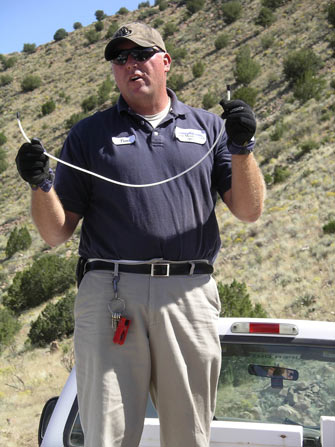
|
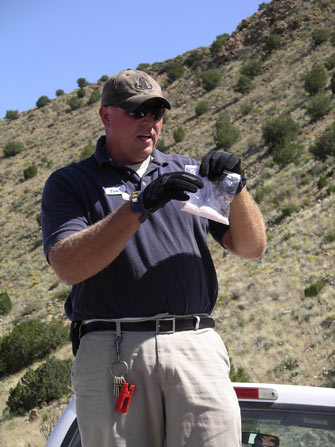
|
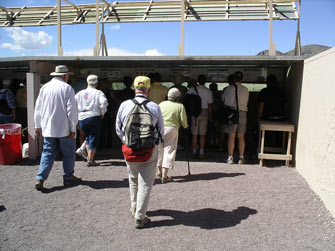
|
Technician describing "det" cord
|
Learning about ANFO
|
Observers Bunker
|
EMRTC has a number of roles for both private and government
interests. One is to teach "first responders" how to deal
with explosives which are becoming more frequent in encounters
with society. Particulary, "home brew" concoctions.
"Pipe bombs" have always been a hazard but now we have such nasty
componds as TATP (triacetone triperoxide) or HTMD (Hexamethylene
triperoxide diamine) both of which can easily be produced in the
home or garage and are extremely dangerous because they're
unstable and shock sensitive. They are often found with
terrorists activities. These two bad guys can also be made
into homemade caps to set off less sensitive explosives.
Professional explosive handlers want nothing to do with them
because of the hazards.
Erythritol Tetranitrate (ETN) is a most interesting explosive for
the amateur experimenter as it's easy to make from an artificial
sweetener and has burn characteristics (8,200 meters/second) that
make it attractive even configured as a "cap" interfaced to a
EBW. This combination can set off most any explosive but
does have a manageable risk of accidental detonation.
We were treated to a lecture on modern explosives, their
application, how they are detonated plus characteristics of
each. We also were shown from the safety of an observing
bunker, four explosions; a blasting cap, 'det' cord, plastic
explosive and 4 lbs of ANFO (Ammonium Nitrate and Fuel Oil).
The biggest explosion and least expensive was the ANFO but it
required a cap to set off plus a small plastic explosive which in
turn set off the ANFO. The plastic is called a 'booster'
because normal ANFO is very insensitive. It was amazing how
powerful only four pounds can be. Explosive use is all about
"speed of burn". The most powerful are not necessarily the
fastest; gasoline releases more energy than most high
explosives. They all have applications.
For many years, the common way to set off explosives was using an
electric blasting cap. With all the use of the radio spectrum
nowadays such as cell phones, two way radios, etc. They're
starting to move away from that approach because transmitters can
induce a current in the blasting cap wires which can accidently
detonate the primary explosive prematurely. The new way is
using "shock cord" which is much safer. They can still be
set off electrically but much shorter lead wires and no
significant explosive on the personnel end.
Det Cord (Detonating Cord) is an explosive that you can
shape. We witnessed cutting a hole in the top of a table but
in practice a heavier version could be used to open a wall for
military or law enforement quick access. Det cord is also
used to connect multiple secondary explosives. Jokingly, Det
Cord is an expensive but quick way to cut trees down.
EMRTC has even tested very small explosives used to inflate air
bags in your automobile.
VLA (Very Large Array)
50 miles West of Socorro and EMRTC in an isolated valley is a
unique Radio Astronomy facility. Called the VLA for Very Large Array.
It was the first major attempt in the US to use multiple large
parabolic dish antenas to synthesize an even bigger one by using
spacial separation of smaller antennas and applying interferometry
techniques. Now a worldwide effort is underway with the VLBI
(Very Long Baseline Interferometry) but the VLA facility is still
very active and is being upgraded to the EVLA (Extended VLA) which
will have modernized electronic equipment.
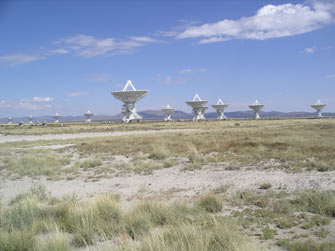
|
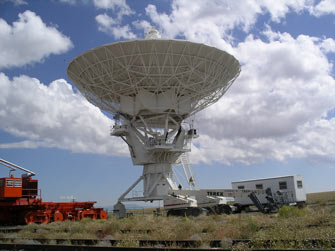
|
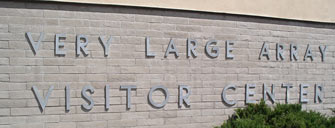
|
Many of the 27 antennas
|
Antenna being serviced
|
|
Interferometry measures the
correlation between signals from antennas at
different locations. This is a measure of how similar two signals
are. The idea is a very powerful one that has led to medical
imaging such as CAT scanners. Mapping of the planet Venus
surface used synthetic aperture radar which is related. The
concept can be applied to radio signals. Modern computing
power has opened up many fields of science that are just beginning
to yield untold results.
How does it work?
For example, if the two antennas do not see a common source of
signal, there will be no similarity between their signals, because
the signals will come from independent sources (mostly LNA noise),
and the correlation will be zero.
On the other hand, if the antennas see a common source, their
signals will have a common part in addition to the independent
part caused by preamplifier noise etc. The common part will in
general arrive at different times to the two antenas (because of
the geometry - different path lengths from the source to each
antenna) and will therefore have a relative delay (time offset)
between the two antennas, This delay is also measured by the
interferometer and is partly reflected in that the correlation is
a complex number.
Obviously, the amount of correlation depends on the power of the
source: a brighter source will produce a bigger common component
(compared to receiver noise) so the correlation will be higher. In
this way an interferometer is similar to a radiometer (total
power) telescope.
But the correlation also depends on the angular brightness
distribution of the source and the antenna spacing (baseline). By
recording the correlation with many different baselines, its
possible to reconstruct an image of the source.
The most popular output of an interferometer are the
"fringes". They are just the real (or imaginary) part of the
correlation, plotted versus time. As the Earth rotates, the delays
change and the phase of the correlation rotates, so its real and
imaginary parts change periodically.
Radio Interferometry and Aperture
Synthesis
The angular resolution, or ability of a radio telescope to
distinguish fine detail in the sky, depends on the wavelength of
observations divided by the size of the instrument. Yet, even the
largest antennas, when used at their shortest operating
wavelength, have an angular resolution only a little better than
one arc minute, which is comparable to that of the unaided human
eye at optical wavelengths. Because radio telescopes operate at
much longer wavelengths than do optical telescopes, radio
telescopes must be much larger than optical telescopes to achieve
the same angular resolution.
At radio wavelengths, the distortions introduced by the
atmosphere are less important than at optical wavelengths, and so
the theoretical angular resolution of a radio telescope can in
practice be achieved even for the largest dimensions. Also,
because radio signals are easy to distribute over large distances
without distortion, it is possible to build radio telescopes of
essentially unlimited dimensions. In fact, the history of radio
astronomy has been one of solving engineering problems to
construct radio telescopes of continually increasing angular
resolution.
The high angular resolution of radio telescopes is achieved by
using the principles of interferometry to synthesize a very large
effective aperture from a number of small elements. In a simple
two-element radio interferometer, the signals from an unresolved,
or "point," source alternately arrive in phase and out of phase as
the Earth rotates and causes a change in the difference in path
from the radio source to the two elements of the interferometer.
This produces interference fringes in a manner similar to that in
an optical interferometer. If the radio source has finite angular
size, then the difference in path length to the elements of the
interferometer varies across the source. The measured interference
fringes from each interferometer pair thus depend on the detailed
nature of the radio "brightness" distribution in the sky.
Each interferometer pair measures one "Fourier component" of the
brightness distribution of the radio source. Work by Australian
and British radio astronomers in the 1950s and 1960s showed that
movable antenna elements combined with the rotation of the Earth
can sample a sufficient number of Fourier components with which to
synthesize the effect of a large aperture and thereby reconstruct
high-resolution images of the radio sky. The laborious
computational task of doing Fourier transforms to obtain images
from the interferometer data is accomplished with high-speed
computers and the fast Fourier transform (FFT), a mathematical
technique that is especially suited for computing discrete Fourier
transforms.
In recognition of their contributions to the development of the
Fourier synthesis technique, more commonly known as aperture
synthesis, or earth-rotation synthesis, Martin Ryle and Antony
Hewish were awarded the 1974 Nobel Prize for Physics. During the
1960s the Swedish radio astronomer, Jan Hogbom developed a
technique called "CLEAN," which is used to remove the spurious
responses from a celestial radio image caused by the use of
discrete, rather than continuous, spacings in deriving the radio
image. Further developments, based on a technique introduced in
the early 1950s by the British scientists Roger Jennison and
Francis Graham Smith, led to the concept of self-calibration,
which is used to remove errors in a radio image due to
uncertainties in the response of individual antennas as well as
small errors introduced by the propagation of radio signals
through the terrestrial atmosphere. In this way radio telescopes
are able to achieve extraordinary angular resolution and image
quality, not possible in any other wavelength band.
Very Long Baseline Interferometry
(VLBI)
In conventional interferometers and arrays, coaxial-cable,
waveguide, or even fiber-optic links are used to distribute a
common local oscillator reference signal to each antenna and also
to return the received signal from an individual antenna to a
central laboratory where it is correlated with the signals from
other antennas. In cases in which antennas are spaced more than a
few tens of kilometers apart, however, it becomes prohibitively
expensive to employ real physical links to distribute the signals.
Very high frequency (VHF) or ultrahigh frequency (UHF) radio links
can be used, but the need for a large number of repeater stations
makes this impractical for spacings greater than a few hundred
kilometers.
Interferometer systems of essentially unlimited element
separation are formed by using the technique of very long baseline
interferometry, or VLBI. In a VLBI system the signals received at
each element are recorded by broad-bandwidth videotape recorders
located at each element. The recorded tapes are then transported
to a common location where they are replayed and the signals
combined to form interference fringes. The successful operation of
a VLBI system requires that the tape recordings be synchronized
within a few millionths of a second and that the local oscillator
reference signal be stable to better than one part in a trillion.
A single magnetic tape capable of recording for several hours can
contain one trillion bits of information, which is roughly
equivalent to storing the entire contents of a modest-sized
library. Hydrogen maser frequency standards are used to give a
timing accuracy of only a few billionths of a second and a
frequency stability of one part in a billion billion.
Needless to say, some of the greatest advances in computerized
computational techniques has come from radio astronomy. In
time, VLBI will be deployed between planets to gain resolution.
Carlsbad Caverns National Monument
Located in the SE corner of New Mexico, these caves are some of
the most impressive in the world. We have been here before
but its still impressive after many years. It takes a full
day just to explore the portion thats open to the public.
Miles of passageways have been found since the early part of the
20th century. Many unexplored sections still exist. Carlsbad
is famous for its bat flights every evening and morning in the
warmer months. It was the bats that first gave its location
away.
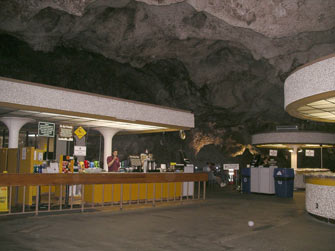
|
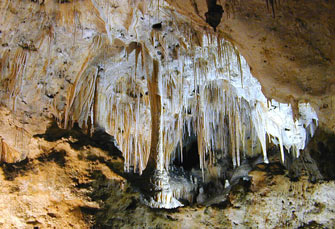
|
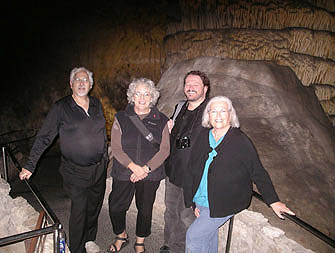
|
Gathering place, 750' underground
|
Typical formations
|
The Chapas plus Marsha
|
Nearby
Lechuguilla cave has currently over 120 miles of passages
identified to a depth of 1,600 feet and is located only 4 miles
from Carlsbad Caverns. It will probably never be opened to
the public for protection. So far no connection between the
two has been found but it would be naive to think that one doesn't
exist.
White Sands Missile Test Range and Monument
White
Sands covers a large area in South Central New Mexico and
in active use by the US Army, Air Force and NASA. The
central hub is Alamogordo in which Holoman AFB is located.
Many military and space exploration rocket engines are tested,
first, in this area. We made a visit to the New Mexico Museum of Space
History.
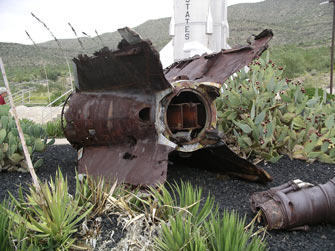
|
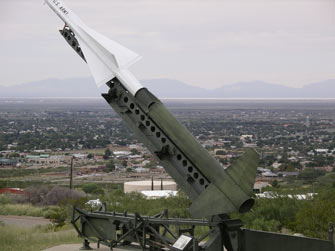
|
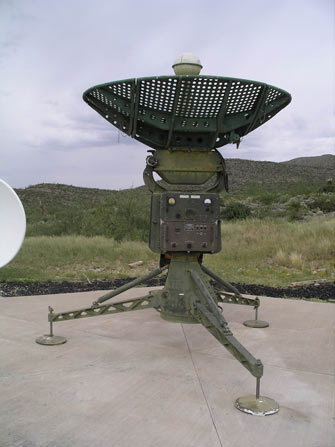
|
Used V2 tail fin from early flights
New Mexico Museum of Space History
|
Nike rocket over Alamogordo
|
Early tracking system |
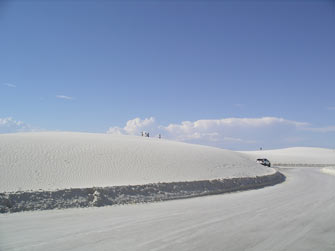
|
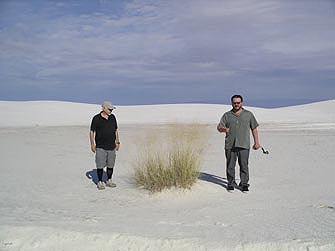
|
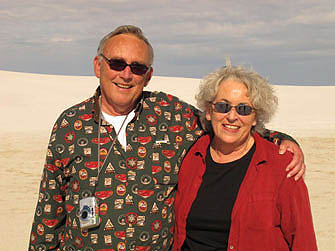
|
Typical sand dunes
White Sands National Monument |
Eric & Donavan
White Sands National Monument |
Neil & Marsha
White Sands National Monument |
White Sands National Monument
is located within the missile test range and may be closed for
a few hours now and then when a test is underway. Its a very
unusual type sand in that its made of gypsum; the same stuff as in
"sheetrock". Not the place to be on a hot summer day!
Albuquerque
By a stroke of luck our trip coincided with the annual balloon festival that
Albuquerque is famous for. It draws a crowd of 100,000 from
around the world and lasts a week.
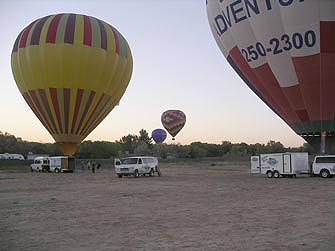
|
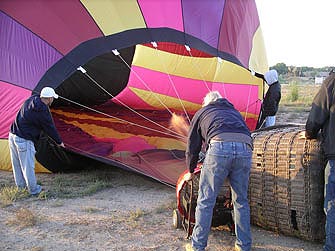
|
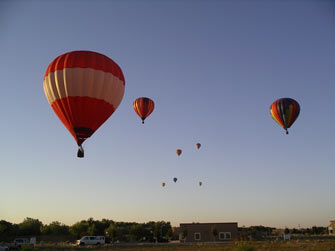
|
| Getting ready |
Inflation |
Just after sunrise |
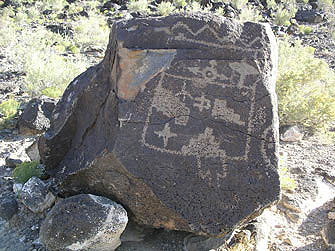 |
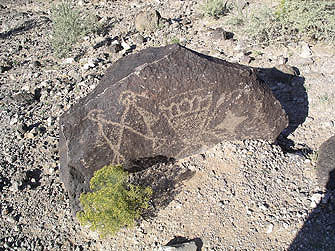 |
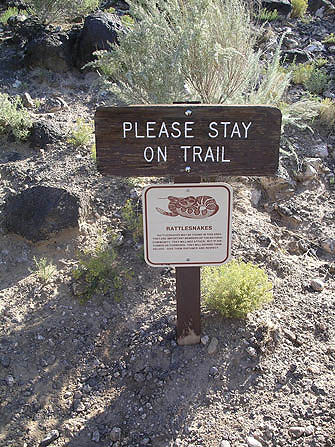 |
Petroglyph National Monument
|
|
Rattlesnake warning |
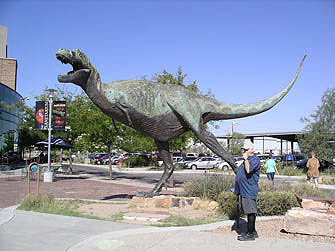
|
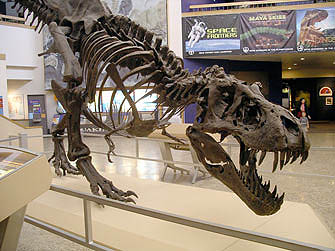
|
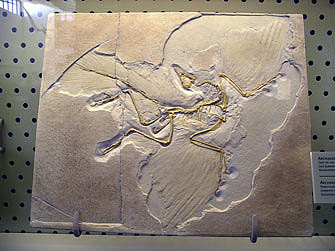
|
New Mexico Museum of Natural History
|
T. Rex
|
Dinosaur with feathers
|
Days can be spent here exploring. Just to the West is Petroglyph National Monument
and in the heart of town are several first class museums.
Santa Fe
This was the final destination on our eighth day. Its known
as an artsy city in Northern New Mexico. Many retirees end
up here as it has a pleasant climate and rich culture. Lots
of shops and museums.
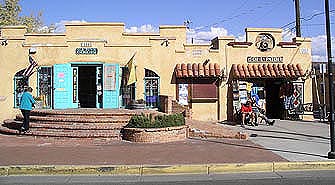 |
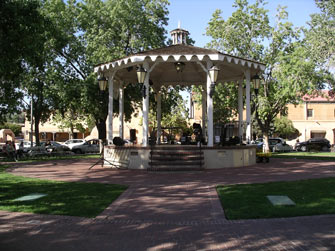 |
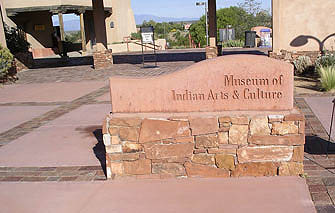 |
Old Town, Santa Fe
|
Town Square
|
Museum of Indian Arts
|
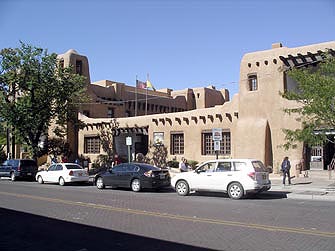 |
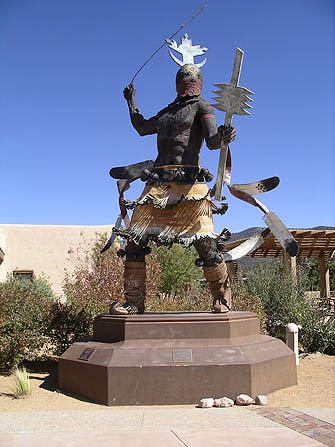 |
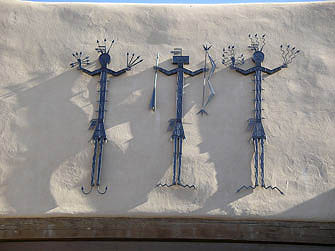 |
Downtown Santa Fe
|
Apache Dancer
Museum of Indian Arts
|
Museum of Indian Arts
|
We intended to drive to Los Alamos and visit the Bradbury museum
but ran out of time.
Neil Robin
Revised: 2/04/2018
 It was important at the
time to study the effects of HEMP
(High Altitude Electromagnetic Pulse) from nuclear
detonations high in the atmosphere. The early days of
testing revealed that something was taking out electronics 100's
of miles distant from the tests. One famous example was the
partial shutdown of the honolulu telephone system during an
atmospheric nuclear test in the mid pacific. Street lights
and other electronics were also effected. This was 800 miles
away! Researchers realized that so called compton electrons
were formed by the gamma
radiation and they needed to find ways of shielding from the very
strong HEMP that was generated. Atmospheric testing had come
to an end by treaty so the scientists decided to build a platform
that could allow full size airplanes to be placed upon it but it
couldn't contain much metal--no metallic nuts and bolts....
nothing metallic. Hence it became the worlds largest
structure made of wood. B-52 shown in the picture is ready
for testing. Kirkland AFB generated a 44 minute movie that
describes its history and construction. You can view it here.
They claimed that they held up testing waiting for our digitizers.
It was important at the
time to study the effects of HEMP
(High Altitude Electromagnetic Pulse) from nuclear
detonations high in the atmosphere. The early days of
testing revealed that something was taking out electronics 100's
of miles distant from the tests. One famous example was the
partial shutdown of the honolulu telephone system during an
atmospheric nuclear test in the mid pacific. Street lights
and other electronics were also effected. This was 800 miles
away! Researchers realized that so called compton electrons
were formed by the gamma
radiation and they needed to find ways of shielding from the very
strong HEMP that was generated. Atmospheric testing had come
to an end by treaty so the scientists decided to build a platform
that could allow full size airplanes to be placed upon it but it
couldn't contain much metal--no metallic nuts and bolts....
nothing metallic. Hence it became the worlds largest
structure made of wood. B-52 shown in the picture is ready
for testing. Kirkland AFB generated a 44 minute movie that
describes its history and construction. You can view it here.
They claimed that they held up testing waiting for our digitizers.
 Over the years Kirkland
AFB had a museum devoted to nuclear weapons and early
testing. I use to enjoy visiting it whenever in town but
9-11 changed all that because public access was closed for
security reasons. Kirkland is a key base in the weapons
program where training takes place. The facility was split
into two parts, the "on base" secure facility and the
Over the years Kirkland
AFB had a museum devoted to nuclear weapons and early
testing. I use to enjoy visiting it whenever in town but
9-11 changed all that because public access was closed for
security reasons. Kirkland is a key base in the weapons
program where training takes place. The facility was split
into two parts, the "on base" secure facility and the 







































